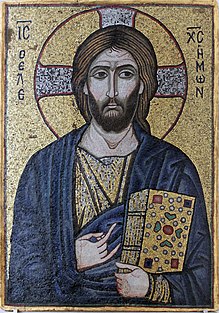Christ the Merciful
The Byzantine mosaic icon Christ the Merciful is one of the treasures of the Museum of Byzantine Art in Berlin (inventory number: 6430). It was acquired from private ownership in 1904. Its provenance is not known (stylistically it belongs to Constantinople ), but it is dated to the first half of the 12th century. The size of the icon suggests that it belonged to the templon of a church.
The wooden frame has the dimensions 74.5 cm × 52.5 cm. It was originally flat, but is now bulged. The material of the Tesserae is glass and stone; they were placed in a wax foundation. There are old patches, and during the 1985 restoration, flaws were added in tinted wax. Due to the bulge, the joint closure of the tesserae is no longer as tight as in the original work of art. The areas of skin (face, hands, neck) consist of very small stones that were specially made for their position in the icon.
Christ is depicted as a half figure on a gold background and with a cross nimbus ; on both sides of the nimbus is the Greek inscription: ΙC ΧC Ο ΕΛΕΗΜΩΝ “Jesus Christ, the Merciful.” He wears a blue robe over a silver chiton decorated with gold effects . The face is turned very slightly to the left, but the gaze is directed to the right. The right hand is raised in the gesture of speech, while the left hand holds a book of the Gospels preciously decorated with precious stones and pearls .
Web links
- German digital library: Christ the Merciful
literature
- Arne Effenberger, Hans Georg Severin: The Museum for Late Antiquity and Byzantine Art / State Museums in Berlin . Philipp von Zabern, Mainz, 1992. ISBN 3-8053-1185-0 . Pp. 242-243.
